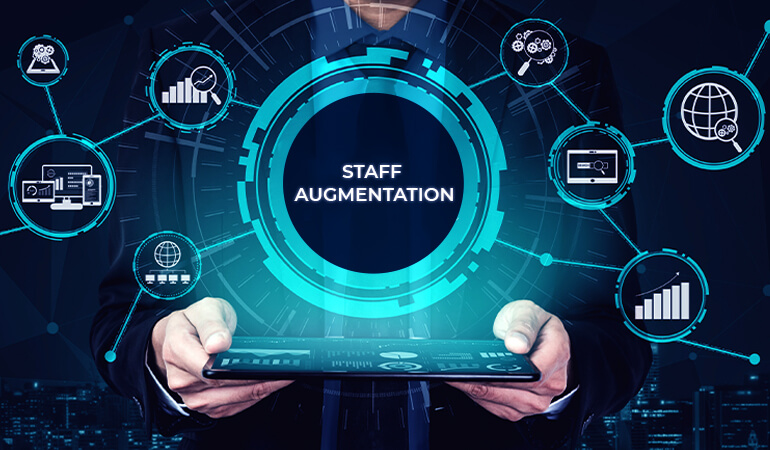In today’s dynamic business environment, staying ahead of the competition requires organizations to be agile, tech-savvy, and adaptable to emerging technologies. However, building and maintaining an elite development team that can tackle evolving challenges can be a daunting task. This is where IT staff augmentation emerges as a strategic solution to address skill gaps and ensure a competitive edge. In this blog, we’ll delve into the meaning of staff augmentation, its significance, various models, and how it can be a game-changer for businesses.
Staff augmentation is a strategic outsourcing practice that involves enlisting specialized talent externally to complement and enhance in-house teams. This approach empowers organizations to swiftly adapt to fluctuating project demands and address specific skill gaps without undergoing the complexities associated with traditional hiring processes. This IT outsourcing company in UK can be beneficial in sourcing out best team for your dreams.
By leveraging staff augmentation, businesses gain a nimble and scalable workforce, ensuring they can promptly assemble the right expertise for distinct tasks or projects. The model also opens up opportunities for accessing a global talent pool, facilitating a broader range of skills and experiences to contribute to organizational objectives. The inherent flexibility and scalability of staff augmentation make it a valuable resource for companies seeking efficient and responsive solutions to their evolving workforce needs.
Types of Staff Augmentation:
- Commodity-based Augmentation:
In the realm of staff augmentation, commodity-based augmentation serves as a pivotal model that organizations often leverage to swiftly address staffing needs. This particular augmentation type involves the addition of more staff to the business, catering to situations where the demand for manpower is urgent, and quick hiring is essential.
- Skill-based Augmentation:
Skill-based augmentation stands out as a strategic approach within the broader framework of staff augmentation, addressing the imperative need for specialized expertise in today’s competitive business landscape. As outlined in the earlier discussion, skill-based augmentation involves the recruitment of professionals with higher levels of education and experience, surpassing the average skill set. This model is particularly relevant when organizations embark on projects that demand a depth of knowledge and proficiency beyond routine tasks.
- Highly-skilled Augmentation:
Highly-skilled augmentation represents a pinnacle in the realm of staff augmentation, designed for organizations seeking exceptional expertise to tackle complex and sophisticated projects. Unlike commodity-based or skill-based augmentation, this model involves recruiting individuals with a top-tier level of proficiency and experience, often from outside organizations. The primary focus is on acquiring talent with specialized knowledge and capabilities that transcend the average skill set, making them instrumental in addressing intricate challenges and pioneering innovations.
- Short-term vs. Long-term Augmentation:
In the realm of staff augmentation, the temporal dimension plays a crucial role, and the distinction between short-term and long-term augmentation models is pivotal. Short-term staff augmentation involves bringing on temporary employees to fulfill specific tasks or projects. This model is particularly beneficial when organizations face immediate needs, such as meeting tight deadlines, handling seasonal workloads, or addressing specific short-duration projects like ad campaigns or event planning.
When to Opt for Staff Augmentation?

- Reinforce Your In-house Team:
When your in-house team is gearing up for a new project or launching a product, staff augmentation becomes a valuable strategy to reinforce your existing workforce. By bringing in additional skilled professionals, you enhance your team’s capabilities and ensure that you have the right expertise to meet the demands of the project.
- Bridge Skill Gaps:
In a dynamic business environment where multiple projects are ongoing simultaneously, each with its unique requirements, skill gaps may emerge. Staff augmentation is an ideal solution to bridge these skill gaps by bringing in experienced professionals with the specific expertise needed for each project.
- Expand Teams Quickly:
In scenarios where there is a sudden need for additional manpower, such as a surge in project requirements or the launch of a new initiative, staff augmentation provides a quick and efficient solution. Rather than going through the lengthy process of local hiring, you can rapidly expand your team by leveraging the augmentation model. This agility is particularly beneficial in meeting tight deadlines and ensuring timely project delivery.
- Meet Project Deadlines:
The time-consuming nature of traditional hiring processes can pose challenges when faced with urgent project deadlines. Staff augmentation offers a streamlined solution, allowing you to augment your IT staff promptly and meet project timelines without compromising on the quality of work. It ensures that you have the required resources in place to deliver projects on schedule, preventing delays that could impact revenue and market launch.
- Other Models Don’t Suit:
Strategic Staff augmentation emerges as an effective strategy in these scenarios, providing flexibility, scalability, and rapid access to a global pool of talent. By strategically opting for staff augmentation, organizations can navigate the challenges of dynamic projects, skill variations, and tight timelines while ensuring efficient and cost-effective workforce management.
Why Staff Augmentation is Popular in the IT Industry?
The IT industry’s rapid growth and the need for specialized skills make staff augmentation a popular choice. With a projected $1,493 billion revenue in the software market by 2025, the demand for a flexible, quick, and cost-effective talent acquisition model is evident. Staff augmentation aligns well with the industry’s hiring needs, offering a swift and efficient solution compared to traditional in-house hiring.

- Rapid Technological Advancements:
The IT industry experiences swift and continuous technological advancements. Staff augmentation allows companies to quickly access specialized skills and expertise, ensuring they stay abreast of the latest technologies without the delays associated with traditional hiring processes.
- Flexibility and Scalability:
IT projects often exhibit varying workloads and fluctuating skill requirements. Staff augmentation provides unparalleled flexibility by allowing organizations to scale their teams up or down based on project demands. This agility is particularly crucial in the IT sector, where project scopes can change rapidly.
- Addressing Skill Gaps:
The diverse and complex nature of IT projects often requires a broad range of skills. Staff augmentation enables companies to bridge skill gaps by bringing in experts for specific tasks or projects, ensuring that they have the right talent to execute complex initiatives successfully.
- Cost-Efficiency:
Strategic Staff augmentation offers cost advantages, especially when compared to the expenses associated with permanent hires. Companies can control costs more effectively by bringing in external resources as needed, avoiding the overheads of salaries, benefits, and training for full-time employees when the demand is temporary.
- Faster Time-to-Market:
In the fast-paced IT landscape, speed is often a critical factor. Staff augmentation accelerates the recruitment process, allowing organizations to assemble teams quickly and reduce time-to-market for their products or services.
Staff Augmentation Services:
1. On-site Staff Augmentation:
This approach fosters close collaboration and seamless integration between augmented staff and the client’s existing team. On-site staff augmentation is particularly beneficial for projects that require hands-on involvement, face-to-face interaction, and real-time communication. The physical presence of augmented professionals within the client’s workspace facilitates immediate access to team members, quick decision-making, and efficient problem-solving.
2. Remote Staff Augmentation:
Remote strategic staff augmentation unlocks a global talent pool, providing access to specialized skills and expertise worldwide. This model is particularly beneficial for organizations needing niche skills or domain-specific knowledge. Cost-effectiveness is a key advantage as it eliminates on-site infrastructure needs and allows flexible team scaling. Enhanced flexibility enables quick adaptation to changing project scopes, leveraging professionals in different time zones.
3. Project-based Staff Augmentation:
Project-based staff augmentation involves hiring external experts for specific project needs without long-term commitments. It offers flexibility, allowing organizations to scale teams based on project demands. Cost-efficient, as it eliminates the need for long-term financial commitments and overhead expenses. Ideal for projects with well-defined scopes, ensuring optimal resource allocation. Streamlined onboarding process for external professionals targeted at fulfilling project requirements.
4. Team-based Staff Augmentation:
Team-based staff augmentation is a strategic staffing approach where organizations opt to hire an entire team of professionals to address specific projects or operational requirements. This model offers a comprehensive solution by assembling individuals with complementary skills and expertise, ensuring a diverse set of capabilities tailored to the project’s needs.
Skills for Right Staff Augmentation Service Provider:

- Expertise and Experience:
Selecting the appropriate staff augmentation service provider hinges on their expertise and experience, particularly within your industry. It is imperative to seek out providers with a well-established track record of success in addressing challenges and delivering results within the specific nuances of your business sector.
- Flexibility and Scalability:
When engaging a staff augmentation service, prioritizing flexibility and scalability is paramount. Confirm that the chosen provider has the capacity to adapt to your evolving needs, allowing you to scale the augmented team up or down as project requirements fluctuate.
- Cultural Fit:
Assessing the cultural fit between your organization and the staff augmentation service provider is crucial for fostering effective collaboration. A harmonious alignment in values, work ethic, and communication styles contributes to a seamless integration of augmented resources into your existing teams.
- Communication and Project Management:
When choosing a staff augmentation service provider, thoroughly evaluate their communication channels and project management capabilities. Clear and effective communication is fundamental to the success of any collaboration. This company for offshore software development can be beneficial in meeting your dreams.
- Talent Pool:
Verifying the depth and diversity of the provider’s talent pool is essential. A reliable staff augmentation service should have access to a broad array of skilled professionals. This ensures that you can swiftly secure resources with the specific expertise required for your projects.
Comparing Staff Augmentation with Other Outsourcing Models:
1. Staff Augmentation vs. Independent Contractors:
When comparing staff augmentation with independent contractors, the key distinctions lie in responsibilities, payroll, and communication dynamics. In a staff augmentation model, the client has direct oversight and management of the augmented resources, including assigning tasks and setting priorities. Payroll remains the client’s responsibility, ensuring direct control over compensation and benefits. Communication channels are typically integrated into the client’s existing framework, fostering seamless collaboration.
2. Staff Augmentation vs. Managed Services:
In the realm of control, the disparity between staff augmentation and managed services becomes evident. Staff augmentation provides the client with a higher degree of control over the augmented resources. The client defines tasks, sets priorities, and manages the team directly. This model is suitable for organizations seeking hands-on involvement in project oversight.
3. Staff Augmentation vs. Dedicated Teams:
Distinguishing between staff augmentation and dedicated teams revolves around the level of responsibility assumed by the vendor. In staff augmentation, the client retains control over project management, with the vendor primarily responsible for providing skilled resources. This model suits clients seeking specific expertise while maintaining control over project execution.
4. Staff Augmentation vs. Offshore Development Centers:
The distinction between building your own team and renting resources becomes apparent in the comparison between staff augmentation and offshore development centers. Staff augmentation enables clients to augment their existing team with specific skills as needed, maintaining flexibility in resource allocation.
5. Staff Augmentation vs. Time and Material (T&M):
When considering payment structures and responsibilities, staff augmentation and time and material (T&M) models present distinct differences. Staff augmentation typically involves a fixed-rate payment for the resources provided, with the client retaining control over project management and tasks. This model is conducive to well-defined projects with stable requirements.
FAQS
1. How Does Staff Augmentation Differ from Other Outsourcing Models?
Staff augmentation involves outsourcing specific talent for projects, while other models like managed services, dedicated teams, and offshore development centers may involve more comprehensive services or long-term partnerships.
2. Why is Staff Augmentation Popular in the IT Industry?
Staff augmentation is popular in the IT industry due to its flexibility, quick hiring process, access to a global talent pool, and alignment with the industry’s dynamic hiring needs. It allows companies to stay agile and responsive to project timelines.
3. What Factors Should be Considered When Choosing a Staff Augmentation Model?
Factors include project duration, cost considerations, data sensitivity, and the need for control over the development process. Understanding these aspects helps in selecting the most suitable staff augmentation model.
4. How Can Organizations Ensure Privacy and Security in Staff Augmentation?
To ensure privacy and security, organizations should conduct regular security audits, implement robust confidentiality agreements, use secure communication channels, and establish clear data protection measures in collaboration with augmented staff.
5. What Challenges Might Arise in Staff Augmentation?
Challenges include potential privacy risks, managerial bottlenecks due to physical and cultural differences, the need for effective quality control, and ensuring that augmented staff possesses the required technical expertise.
6. How Does Staff Augmentation Contribute to Cost Reduction?
Staff augmentation contributes to cost reduction by eliminating the need for benefits, leaves, taxes, and additional recruitment expenses. Businesses pay for the specific hours or services provided, optimizing costs.
7. Can Staff Augmentation Be Used for Both Short-Term and Long-Term Projects?
Yes, staff augmentation is versatile and can be used for both short-term projects, where temporary expertise is needed, and long-term projects requiring sustained collaboration. The model allows organizations to adjust the duration based on their needs.



